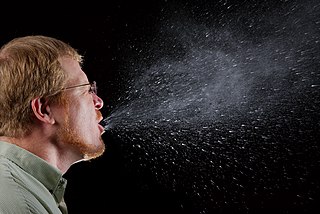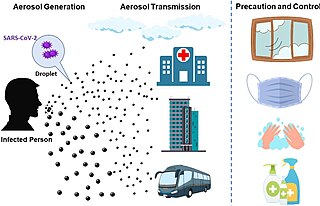Related Research Articles

Bioterrorism is terrorism involving the intentional release or dissemination of biological agents. These agents include bacteria, viruses, insects, fungi, and/or toxins, and may be in a naturally occurring or a human-modified form, in much the same way as in biological warfare. Further, modern agribusiness is vulnerable to anti-agricultural attacks by terrorists, and such attacks can seriously damage economy as well as consumer confidence. The latter destructive activity is called agrobioterrorism and is a subtype of agro-terrorism.

Plague is an infectious disease caused by the bacterium Yersinia pestis. Symptoms include fever, weakness and headache. Usually this begins one to seven days after exposure. There are three forms of plague, each affecting a different part of the body and causing associated symptoms. Pneumonic plague infects the lungs, causing shortness of breath, coughing and chest pain; bubonic plague affects the lymph nodes, making them swell; and septicemic plague infects the blood and can cause tissues to turn black and die.

Botulism is a rare and potentially fatal illness caused by a toxin produced by the bacterium Clostridium botulinum. The disease begins with weakness, blurred vision, feeling tired, and trouble speaking. This may then be followed by weakness of the arms, chest muscles, and legs. Vomiting, swelling of the abdomen, and diarrhea may also occur. The disease does not usually affect consciousness or cause a fever.

Botulinum toxin, or botulinum neurotoxin, is a highly potent neurotoxic protein produced by the bacterium Clostridium botulinum and related species. It prevents the release of the neurotransmitter acetylcholine from axon endings at the neuromuscular junction, thus causing flaccid paralysis. The toxin causes the disease botulism. The toxin is also used commercially for medical and cosmetic purposes.

Clostridium botulinum is a Gram-positive, rod-shaped, anaerobic, spore-forming, motile bacterium with the ability to produce the neurotoxin botulinum.
In medicine, public health, and biology, transmission is the passing of a pathogen causing communicable disease from an infected host individual or group to a particular individual or group, regardless of whether the other individual was previously infected. The term strictly refers to the transmission of microorganisms directly from one individual to another by one or more of the following means:

Autonomous Detection Systems (ADS), also called biohazard detection systems or autonomous pathogen detection systems, are designed to monitor air or water in an environment and to detect the presence of airborne or waterborne chemicals, toxins, pathogens, or other biological agents capable of causing human illness or death. These systems monitor air or water continuously and send real-time alerts to appropriate authorities in the event of an act of bioterrorism or biological warfare.
Pulmonary hygiene, formerly referred to as pulmonary toilet, is a set of methods used to clear mucus and secretions from the airways. The word pulmonary refers to the lungs. The word toilet, related to the French toilette, refers to body care and hygiene; this root is used in words such as toiletry that also relate to cleansing.
Microbial toxins are toxins produced by micro-organisms, including bacteria, fungi, protozoa, dinoflagellates, and viruses. Many microbial toxins promote infection and disease by directly damaging host tissues and by disabling the immune system. Endotoxins most commonly refer to the lipopolysaccharide (LPS) or lipooligosaccharide (LOS) that are in the outer plasma membrane of Gram-negative bacteria. The botulinum toxin, which is primarily produced by Clostridium botulinum and less frequently by other Clostridium species, is the most toxic substance known in the world. However, microbial toxins also have important uses in medical science and research. Currently, new methods of detecting bacterial toxins are being developed to better isolate and understand these toxins. Potential applications of toxin research include combating microbial virulence, the development of novel anticancer drugs and other medicines, and the use of toxins as tools in neurobiology and cellular biology.

Airborne transmission or aerosol transmission is transmission of an infectious disease through small particles suspended in the air. Infectious diseases capable of airborne transmission include many of considerable importance both in human and veterinary medicine. The relevant infectious agent may be viruses, bacteria, or fungi, and they may be spread through breathing, talking, coughing, sneezing, raising of dust, spraying of liquids, flushing toilets, or any activities which generate aerosol particles or droplets. This is the transmission of diseases via transmission of an infectious agent, and does not include diseases caused by air pollution.
Influenza prevention involves taking steps that one can use to decrease their chances of contracting flu viruses, such as the Pandemic H1N1/09 virus, responsible for the 2009 flu pandemic.

A respiratory droplet is a small aqueous droplet produced by exhalation, consisting of saliva or mucus and other matter derived from respiratory tract surfaces. Respiratory droplets are produced naturally as a result of breathing, speaking, sneezing, coughing, or vomiting, so they are always present in our breath, but speaking and coughing increase their number.

A powder is a dry, bulk solid composed of many very fine particles that may flow freely when shaken or tilted. Powders are a special sub-class of granular materials, although the terms powder and granular are sometimes used to distinguish separate classes of material. In particular, powders refer to those granular materials that have the finer grain sizes, and that therefore have a greater tendency to form clumps when flowing. Granulars refer to the coarser granular materials that do not tend to form clumps except when wet.
Dustiness is the tendency of particles to become airborne in response to a mechanical or aerodynamic stimulus. Dustiness is affected by the particle shape, size, and inherent electrostatic forces. Dustiness increases the risk of inhalation exposure.
A toilet plume is the dispersal of microscopic particles as a result of flushing a toilet. Normal use of a toilet by healthy individuals is considered unlikely to be a major health risk. However this dynamic changes if an individual is fighting an illness and currently shedding out a virulent pathogen in their urine, feces or vomitus. There is indirect evidence that specific pathogens such as norovirus or SARS coronavirus could potentially be spread by toilet aerosols, but as of 2015, no direct experimental studies had clearly demonstrated or refuted actual disease transmission from toilet aerosols. It has been hypothesized that dispersal of pathogens may be reduced by closing the toilet lid before flushing, and by using toilets with lower flush energy.
Vaping-associated pulmonary injury (VAPI), also known as vaping-associated lung injury (VALI) or e-cigarette, or vaping, product use associated lung injury (E/VALI), is an umbrella term, used to describe lung diseases associated with the use of vaping products that can be severe and life-threatening. Symptoms can initially mimic common pulmonary diagnoses, such as pneumonia, but sufferers typically do not respond to antibiotic therapy. Differential diagnoses have overlapping features with VAPI, including COVID-19. According to an article in the Radiological Society of North America news published in March 2022, EVALI cases continue to be diagnosed. “EVALI has by no means disappeared,” Dr. Kligerman said. “We continue to see numerous cases, even during the pandemic, many of which are initially misdiagnosed as COVID-19.”
An aerosol-generating procedure (AGP) is a medical or health-care procedure that a public health agency such as the World Health Organization or the United States Centers for Disease Control and Prevention (CDC) has designated as creating an increased risk of transmission of an aerosol borne contagious disease, such as COVID-19. The implication is that the risk of transmission of the contagious disease from a patient having an AGP performed on them is higher than for a patient who is not having an AGP performed upon them. This then informs decisions on infection control, such as what personal protective equipment (PPE) is required by a healthcare worker performing the medical procedure.

Source control is a strategy for reducing disease transmission by blocking respiratory secretions produced through speaking, coughing, sneezing or singing. Surgical masks are commonly used for this purpose, with cloth face masks recommended for use by the public only in epidemic situations when there are shortages of surgical masks. In addition, respiratory etiquette such as covering the mouth and nose with a tissue when coughing can be considered source control. In diseases transmitted by droplets or aerosols, understanding air flow, particle and aerosol transport may lead to rational infrastructural source control measures that minimize exposure of susceptible persons.

The transmission of COVID-19 is the passing of coronavirus disease 2019 from person to person. COVID-19 is mainly transmitted when people breathe in air contaminated by droplets/aerosols and small airborne particles containing the virus. Infected people exhale those particles as they breathe, talk, cough, sneeze, or sing. Transmission is more likely the closer people are. However, infection can occur over longer distances, particularly indoors.

Pulmonary drug delivery is a route of administration in which patients use an inhaler to inhale their medications and drugs are absorbed into the bloodstream via the lung mucous membrane. This technique is most commonly used in the treatment of lung diseases, for example, asthma and chronic obstructive pulmonary disease (COPD). Different types of inhalers include metered-dose inhalers (MDI), dry powder inhalers (DPI), soft mist inhalers (SMI) and nebulizers. The rate and efficacy of pulmonary drug delivery are affected by drug particle properties, breathing patterns and respiratory tract geometry.
References
- ↑ "Kelly K. Houston Inventions, Patents and Patent Applications - Justia Patents Search". patents.justia.com.
- ↑ Tang, J. W.; Settles, G. S. (2008). "Coughing and Aerosols". New England Journal of Medicine. 359 (15): e19. doi: 10.1056/NEJMicm072576 . PMID 18843121.
- ↑ "Microbe-laden aerosols" (PDF). Microbiology Today (November 2005). Archived from the original (PDF 217 KB) on 2007-10-14.
- ↑ Johnson, G. R.; Morawska, L. (2009). "The Mechanism of Breath Aerosol Formation". Journal of Aerosol Medicine and Pulmonary Drug Delivery. 22 (3): 229–237. CiteSeerX 10.1.1.651.7875 . doi:10.1089/jamp.2008.0720. PMID 19415984.
- ↑ "Norovirus, Clinical Overview". Centers for Disease Control and Prevention (CDC). 2018-12-21.
- ↑ Best, E. L.; Sandoe, J. A. T.; Wilcox, M. H. (2012). "Potential for aerosolization of Clostridium difficile after flushing toilets: The role of toilet lids in reducing environmental contamination risk". Journal of Hospital Infection. 80 (1): 1–5. doi:10.1016/j.jhin.2011.08.010. PMID 22137761.
- ↑ "Hantavirus Pulmonary Syndrome (HPS): What You Need To Know" (PDF 1.4 MB). CDC. 2018-02-12.
- ↑ "Botulinum Toxin as a Biological Weapon". Center For Infectious Disease Research & Policy. Archived from the original on 2013-05-06. Retrieved 2012-05-02.
- ↑ Ding, Yaobo; Stahlmecke, Burkhard; Jiménez, Araceli Sánchez; Tuinman, Ilse L.; Kaminski, Heinz; Kuhlbusch, Thomas A. J.; Van Tongeren, Martie; Riediker, Michael (2015). "Dustiness and Deagglomeration Testing: Interlaboratory Comparison of Systems for Nanoparticle Powders". Aerosol Science and Technology. 49 (12): 1222–1231. doi: 10.1080/02786826.2015.1114999 .